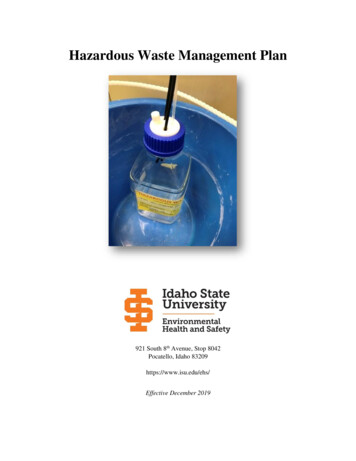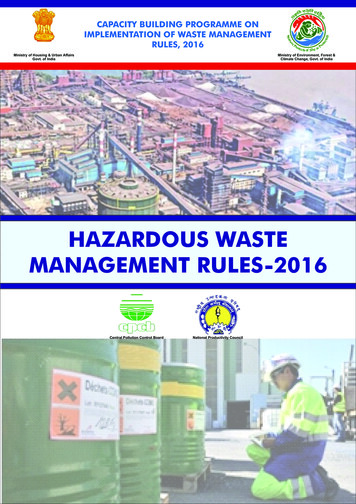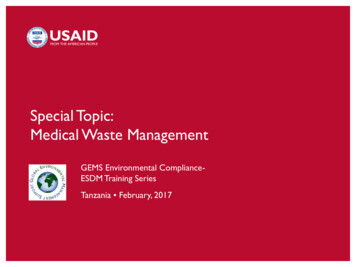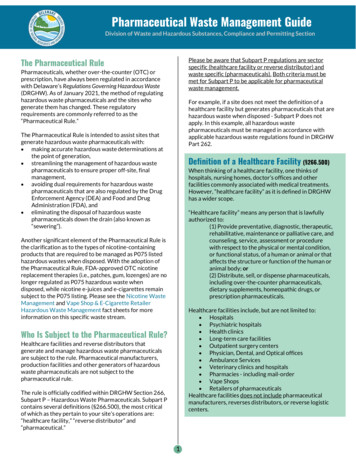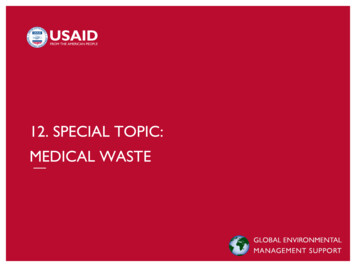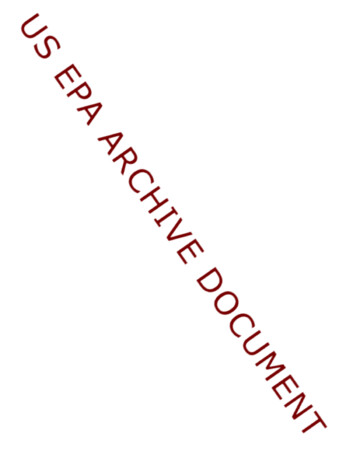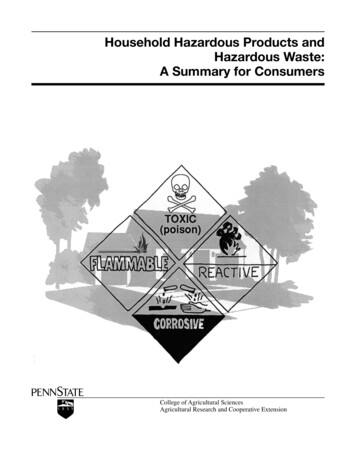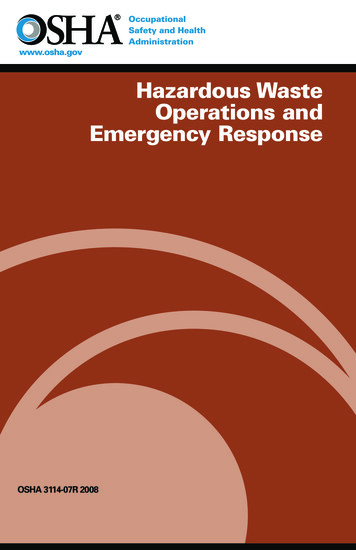
Transcription
Hazardous WasteOperations andEmergency ResponseOSHA 3114-07R 2008
Employers are responsible for providing a safeand healthy workplace for their employees.OSHA’s role is to promote the safety and health ofAmerica’s working men and women by setting andenforcing standards; providing training, outreachand education; establishing partnerships; andencouraging continual improvement in workplacesafety and health.This informational booklet provides a generaloverview of a particular topic related to OSHAstandards. It does not alter or determine compliance responsibilities in OSHA standards or theOccupational Safety and Health Act of 1970.Because interpretations and enforcement policymay change over time, you should consult currentOSHA administrative interpretations and decisionsby the Occupational Safety and Health ReviewCommission and the courts for additional guidanceon OSHA compliance requirements.This publication is in the public domain and may bereproduced, fully or partially, without permission.Source credit is requested but not required.This information is available to sensory impairedindividuals upon request. Voice phone: (202) 6931999; teletypewriter (TTY) number: (877) 889-5627.Edwin G. Foulke, Jr.Assistant Secretary of Labor forOccupational Safety and Health
Hazardous WasteOperations andEmergency ResponseU.S. Department of LaborOccupational Safety and Health AdministrationOSHA 3114-07R2008
ContentsIntroduction.5Scope and Application.6Provisions of HAZWOPER for Cleanup Operations.9Safety and Health Program.9Organizational Structure.9Comprehensive Workplan.10Site Characterization and Analysis.10Health and Safety Plan (HASP).11Safety and Health Training Program.13Medical Surveillance.15Engineering Controls, Work Practices, and PPE.17Exposure Monitoring.19Informational Programs.20Handling and Labeling Drums and Containers.20Decontamination Procedures.22Hazardous Waste Site Emergency Response.23Sanitation of Temporary Workplaces.24New Technology Programs.24Provisions of HAZWOPER for TSD Facilities.25Safety and Health Program.25Hazard Communication Program.25Medical Surveillance, Decontamination, NewTechnology, and Material Handling Programs.26Training Program.26TSD Facility Emergency Response.27Provisions of HAZWOPER for EmergencyResponse Operations.28Emergency Response Plan.29Procedures for Handling an Emergency Response.29Training.30Medical Surveillance.32PPE.33Post-Emergency Response Operations.33Related Requirements.34Recordkeeping.34Hazard Communication Standard (HCS).35Bloodborne Pathogens Standard (BBP).35Other OSHA Standards.36Other Resources.36Summary.37OSHA Assistance.38OSHA Regional Offices.432
This guidance document is not a standard or regulation,and it creates no new legal obligations. The document isadvisory in nature, informational in content, and is intendedto assist employers in providing a safe and healthy workplace. The Occupational Safety and Health Act requiresemployers to comply with hazard-specific safety and healthstandards promulgated by OSHA or by a State with anOSHA-approved State Plan. In addition, pursuant to Section5(a)(1), the General Duty Clause of the Act, employers mustprovide their employees with a workplace free from recognized hazards likely to cause death or serious physicalharm. Employers can be cited for violating the General DutyClause if there is a recognized hazard and they do not takereasonable steps to prevent or abate the hazard. However,failure to implement these recommendations is not, in itself,a violation of the General Duty Clause. Citations can only bebased on standards, regulations, and the General DutyClause.3
ACRONYMSBBPBloodborne PathogensCERCLAComprehensive Environmental Response, Compensation,and Liability Act of 1980CESQGsConditionally Exempt Small Quantity GeneratorsCFRCode of Federal RegulationsDHSDepartment of Homeland SecurityDOTDepartment of TransportationEPAEnvironmental Protection AgencyERPEmergency Response PlanHASPHealth and Safety PlanHAZMATHazardous MaterialsHAZWOPER Hazardous Waste Operations and Emergency Response4HCSHazard Communication StandardICSIncident Command SystemIDLHImmediately Dangerous to Life or HealthMSDSMaterial Safety Data SheetNIMSNational Incident Management SystemNPLNational Priority ListOSHAOccupational Safety and Health AdministrationPELPermissible Exposure LimitPPEPersonal Protective EquipmentRCRAResource Conservation and Recovery Act of 1976SARASuperfund Amendments and Reauthorization Act of 1986SCBASelf-contained breathing apparatusSHARPSafety and Health Achievement Recognition ProgramSSPSkilled Support PersonnelTSDTreatment, Storage, and DisposalTRIToxic Release InventoryUSTUnderground storage tankVPPVoluntary Protection Programs
IntroductionThe dumping of hazardous substances poses a significant threat tothe environment. The U.S. Environmental Protection Agency’s (EPA)Toxic Release Inventory (TRI) data show that over 18 million tons ofhazardous substances covered by TRI were disposed of or releasedinto the environment from 1998 through 2004.1 Hazardous substances are a serious safety and health problem that continues toendanger human and animal life and environmental quality. Discarded hazardous substances that are toxic, flammable, or corrosive can cause fires, explosions, and pollution of air, water, andland. Unless hazardous substances are properly treated, stored, ordisposed of, they will continue to do great harm to living things thatcontact them, now and in the future.Because of the seriousness of the safety and health hazardsrelated to hazardous waste operations and emergency response,the Occupational Safety and Health Administration (OSHA) issuedits Hazardous Waste Operations and Emergency Response(HAZWOPER) standard, Title 29 Code of Federal Regulations (CFR)Parts 1910.120 and 1926.65 (see 54 Federal Register 9294-9336,March 6, 1989) to protect employees in this environment and tohelp them handle hazardous substances safely and effectively.The HAZWOPER standard for the construction industry, 29 CFR1926.65, is identical to 29 CFR 1910.120. For brevity, the HAZWOPERstandard is referenced as 1910.120 throughout the remainder of thispublication.The HAZWOPER standard covers all employers performing thefollowing three general categories of work operations: Hazardous waste site cleanup operations [paragraphs (b)-(o)](e.g., SUPERFUND cleanup), Operations involving hazardous waste that are conducted attreatment, storage, and disposal (TSD) facilities [paragraph (p)](e.g., landfill that accepts hazardous waste), and1U.S. Environmental Protection Agency, TRI 2004 Public Data 5
Emergency response operations involving hazardous substancereleases [paragraph (q)] (e.g., chemical spill at a manufacturingplant).An understanding of how each of these sections are differentfrom each other and what they apply to is essential to ensure compliance with the appropriate section of HAZWOPER. The scope andapplication [paragraphs (a)(1) and (a)(2)] sections of the standarddefine these work operations and indicate what sections of thestandard they fall under.State, county, and municipal employees, including hazardouswaste treatment, storage and disposal facility employees, and firstresponders, such as fire and rescue personnel, police, and medicalpersonnel, are covered by HAZWOPER and other regulations issuedby the 26 states and territories operating their own OSHA-approvedsafety and health programs (see listing at the end of this booklet orvisit OSHA’s website at www.osha.gov). EPA HAZWOPER regulationscover these employees in states without OSHA-approved state plans.The EPA adopted the HAZWOPER standard at 40 CFR Part 311 forpublic employees (either compensated or non-compensated) whoperform operations within the scope of the standard in states thatdo not have an OSHA-approved state plan.This booklet provides an overview of the HAZWOPER requirements for each type of work operation and explains each sectionseparately to provide a clearer understanding of the standard.Having this understanding enables employers to protect the healthand safety of their employees in these different environments.Scope and ApplicationAs briefly discussed in the introduction, HAZWOPER covers threecategories of work operations. First, paragraphs (b)-(o) of thestandard regulate those operations where employees are engaged inthe cleanup of uncontrolled hazardous waste sites. These operationsinclude those hazardous substance operations under the ComprehensiveEnvironmental Response, Compensation, and Liability Act of 1980as amended (CERCLA), including initial investigations at CERCLAsites before the presence or absence of hazardous substances has6
been determined. Examples of types of uncontrolled hazardouswaste sites that would be covered by HAZWOPER include those: Listed or proposed for listing on the National Priority List (NPL), Listed or proposed for listing on a State priority list, Identified or listed by a governmental agency as an uncontrolledhazardous waste site (Note: this includes voluntary cleanupoperations), and Regulated as a corrective action covered by the ResourceConservation and Recovery Act (RCRA).The second category of work operation is covered by paragraph(p) and includes those employees engaged in operations involvinghazardous waste TSD facilities regulated under 40 CFR Parts 264and 265 pursuant to the RCRA. There are certain types of employerswho are exempted from paragraph (p) and these are addressed inthe section covering provisions for TSD facilities.The third and final work operation category is covered byparagraph (q) and includes those employees engaged in emergencyresponse operations for releases of, or substantial threats of releasesof, hazardous substances without regard to the location of thehazard. Paragraph (q) also includes provisions for post-emergencyresponse operations, such as performing any necessary cleanupactivity. Table 1 provides a summary of the scope and applicationof the standard, including some example work activities.7
Table 1 – Scope and Application of HAZWOPERWork OperationCleanup Operations Cleanup operations required by agovernmental body or other operationsinvolving hazardous substances that areconducted at uncontrolled hazardouswaste sites. Corrective actions involving cleanupoperations at sites covered by RCRA. Voluntary cleanup operations at sitesrecognized by federal, state, local, orother governmental bodies asuncontrolled hazardous waste sites.Operations at TSD FacilitiesOperations involving hazardous wasteconducted at TSD facilities regulated by40 CFR 264 and 265 pursuant to RCRAor by agencies under agreement withthe EPA to implement RCRA regulations.Emergency Response OperationsEmergency response operations forreleases of, or substantial threats ofreleases of, hazardous substanceswithout regard to the location of (b)-(o)1910.120(p)1910.120(q)Examples ofWork Activities Site Characterization ofHazardous Waste Site Drum Removal Contaminated SoilRemoval Underground StorageTank (UST) Removal Treating Waste forDisposal at RCRALandfill Handling Waste atRCRA Landfill Response to the spill ofa highly toxic substancefrom overturned 55gallon drum Response to leakingstorage tank Response to overturnedtruck carrying hazardousmaterials Response to chemicalfire
Provisions of HAZWOPER forCleanup OperationsSafety and Health ProgramAn effective and comprehensive safety and health program isessential in reducing work-related injuries and illnesses and inmaintaining a safe and healthful work environment. The standard,therefore, requires each employer to develop and implement awritten safety and health program that identifies, evaluates, andcontrols safety and health hazards, and provides emergencyresponse procedures for each hazardous waste site. This writtenprogram must include specific and detailed information on thefollowing topics: An organizational structure, A comprehensive workplan, A site-specific safety and health plan (often referred to as ahealth and safety plan or HASP), A safety and health training program, A medical surveillance program, andStandard operating procedures.The written safety and health program must be periodicallyupdated and made available to all affected employees, contractors,and subcontractors. Necessary coordination between the generalprogram and site-specific activities also should be included in theprogram. The employer also must inform contractors and subcontractors, or their representatives, of any identifiable safety andhealth hazards or potential fire or explosion hazards before theyenter the worksite. Organizational StructureThe organizational structure part of the program establishes theoverall chain of command as well as the roles and responsibilitiesassigned to supervisors and employees. The organizationalstructure must, at a minimum, include the following elements: A general supervisor with the responsibility and authority todirect all hazardous waste site operations,9
A site safety and health supervisor who develops and implementsthe HASP and is responsible for ensuring compliance, and The roles and responsibilities of all the other site personnelnecessary for hazardous waste site operations.Comprehensive WorkplanPlanning is the key element in a hazardous waste cleanup program.Proper planning will greatly reduce employee hazards at hazardouswaste sites. A workplan should support the overall objectives of thecleanup program and provide procedures for implementation, andincorporate the employer’s standard operating procedures for safetyand health.The plan must define the tasks and objectives of site operationsas well as the logistics and resources required to fulfill these tasks.For example, the following topics must be addressed: The anticipated cleanup and operating procedures, A definition of work tasks and objectives, and methods ofaccomplishment, The established personnel requirements for implementing theplan, and Procedures for implementing training, informational programs,and medical surveillance requirements.Site Characterization and AnalysisSite characterization and analysis is the process of identifyingspecific site hazards and determining the appropriate safety andhealth control procedures necessary to protect site employees.The more accurate, detailed, and comprehensive the informationavailable about a site, the more the protective measures can betailored to the actual hazards that the employees may encounter.At each phase of site characterization, information is obtained andevaluated to define the potential hazards of the site. Much of theinformation obtained from the initial site characterization is used inthe development of the site health and safety plan (HASP) requiredin 1910.120(b)(4). (Note: the site HASP is addressed further in thenext section.)10
A preliminary evaluation of the site’s characteristics must beperformed prior to site entry. A secondary more detailed evaluationmust be conducted to further identify existing hazards to aid in theselection of appropriate engineering controls and personal protective equipment (PPE) for future site activities. The evaluationmust include all suspected conditions that are immediately dangerous to life or health (IDLH) or that may cause serious harm toemployees (e.g., confined space entry, potentially explosive orflammable situations, visible vapor clouds, etc.). As available, theevaluation must include the location and size of the site, sitetopography, site accessibility by air and roads, pathways forhazardous substances to disperse, a description of employeeduties, and the time needed to perform a given task, as well as thepresent status and capabilities of the emergency response teams.Additional requirements of the site characterization involve thefollowing: PPE to be used during initial site entry, Exposure monitoring for ionizing radiation and other IDLHconditions. (Note: An ongoing air monitoring program inaccordance with paragraph (h) of HAZWOPER must beimplemented after site characterization has determined thatit is safe to begin start-up or cleanup operations), and Risk identification based on the presence and concentrations ofhazardous substances and communication of the risks to thoseemployees who will be working on the site.Health and Safety Plan (HASP)A HASP is a critical program element that aids in eliminating oreffectively controlling anticipated safety and health hazards. TheHASP must be unique to the site and address all of the elementsunder paragraph (b)(4)(ii), including: Hazard analysis for each site task, Employee training, Personal protective equipment (PPE) to be used by employeesand based on hazard analysis, Medical surveillance,11
Exposure monitoring, Site control measures, Decontamination procedures, Emergency response plan, Confined space entry procedures, andSpill containment.Although some of the above elements are a part of the overallsafety and health program, several others are additional to theseelements and are crucial in developing an effective HASP. Forexample, the task hazard analysis may be the most criticalcomponent of the site HASP and addresses the chemical, physical,and biological hazards associated with each particular task oroperation and the control procedures that protect employees whenthey perform that task. Information obtained from the hazardanalysis provides the basis for making important decisionsregarding the selection of PPE, medical monitoring, exposuremonitoring, etc.It is important to thoroughly address in the HASP how exposuremonitoring will be performed as this is necessary for the protectionof site employees. Critical information includes the frequency andtypes of air monitoring, personnel monitoring, environmentalsampling techniques and instrumentation including calibration andmaintenance methods, as well as the interpretation of monitoringresults. For example, there should be established criteria fordetermining when to upgrade or downgrade PPE based onexposure monitoring results.Another important element of the HASP is site control, whichinvolves controlling the activities of employees and the movementof equipment which minimizes potential contamination of employees. Site control also protects the general public from sitehazards and can prevent trespassing and vandalism. The followinginformation is useful in developing and implementing a site controlprogram: a site map; site work zones; site communication; safework practices; and the name, location, and phone number of thenearest medical assistance.The use of a "buddy system" is also required as a protectivemeasure to assist in the rescue of an employee who becomesunconscious, trapped, or seriously disabled on site. In the buddy 12
system, two employees must keep in visual contact with each otherand only one employee should be in a specific dangerous area at anyone time, so that if one gets in trouble the second can call for help.The written HASP must be kept at the site and must always beavailable for employee, contractor, or subcontractor review. Preentry briefings must be conducted prior to site entry and at othertimes as necessary to ensure that employees are aware of theHASP and its implementation. The employer also must ensure thatperiodic safety and health inspections are made of the site and thatall known deficiencies are corrected prior to work at the site.OSHA has developed an interactive software program (e-HASP2)that assists employers in developing an appropriate HASP. ThiseTool integrates decision logic and a large chemical database toassist the user in determining appropriate controls for site healthand safety hazards. After site-specific information has been entered,the program generates reports with “model” language that isacceptable to OSHA in preparing a site-specific HASP. This eToolcan be found on OSHA’s Hazardous Waste web page.Safety and Health Training ProgramA training program is required under the safety and health programand is also part of the site HASP. This training must be provided toall employees who will work on the site such as equipment operators, general laborers, and supervisors or managers who may haveexposure to hazardous substances.Before performing any work on a hazardous waste site, theemployer must provide its employees with initial training basedon the tasks and operations that employees will perform and theexposures they are anticipated to experience (see Table 2). Employeeswho have “equivalent” experience and skills from previous workexperience and/or training would not have to receive the initialtraining provided that the employer can verify it through documentation or certification. Equivalently trained employees who are new to asite must still receive site-specific training before site entry.Training makes employees aware of the potential hazards theymay encounter and provides the necessary knowledge and skillsto perform their work with minimal risk to their own, and otheremployees’, safety and health. Both supervisors and employees13
must be trained to recognize hazards and to prevent them; toselect, care for, and use respirators properly, as well as other typesof PPE; to understand engineering controls and their use; to useproper decontamination procedures; to understand the emergencyresponse plan, medical surveillance requirements, confined spaceentry procedures, spill containment program, and any appropriatework practices. Employees also must know the names of personneland their alternates responsible for site safety and health. Sitepersonnel who are expected to respond to emergency situations atthe site must receive additional training in how to respond toanticipated emergencies (e.g., fires/explosions, hazardous spills, etc.).Table 2 – Training Requirements – Hazardous Waste Cleanup OperationsWorkers [1910.120(e)(3)] General site employees (e.g., equipmentoperators, general laborers, etc.)[1910.120(e)(3)(i)]40 hours initial training24 hours supervised field experience8 hours annual refresher Employees occasionally on site for alimited task (e.g., groundwatermonitoring, land surveying, etc.)with minimal exposure [1910.120(e)(3)(ii)]24 hours initial training8 hours supervised field experience8 hours annual refresher Employees regularly on site who arenot exposed to health hazards[1910.120(e)(3)(iii)]24 hours initial training8 hours supervised field experience8 hours annual refresher Employees under (e)(3)(ii) or (iii) whobecome general site workers under(e)(3)(i) [(e)(3)(iv)]16 hours of additional training16 hours of additional supervisedfield experienceSupervisors/Managers [1910.120(e)(4)] Supervisors of general site employees(e.g., equipment operators, generallaborers, etc.)40 hours initial training24 hours supervised field experience8 hours of specialized training in employer’ssafety and health-related programs8 hours annual refresher Supervisors of employees occasionally onsite for a limited task (e.g., groundwatermonitoring, land surveying, etc.) withminimal exposure24 hours initial training8 hours supervised field experience8 hours specialized training in employer’ssafety and health-related programs8 hours annual refresher Supervisors of employees regularly onsite who are not exposed to healthhazards24 hours initial training8 hours supervised field experience8 hours specialized training in employer’ssafety and health-related programs8 hours annual refresher14
Employees at all sites must not perform any hazardous wasteoperations unless they have been trained to the level required bytheir job function and responsibility, and have been certified by aqualified trainer as having completed the necessary training.Employees who receive the specified training must receive awritten certificate upon successful completion of that training. Thattraining need not be repeated if the employee goes to work at anew site; however, the employee must receive the necessaryadditional site-specific training needed to work safely at the newsite. All employees must receive 8 hours of annual refreshertraining as indicated in Table 2.It is critically important for a portion of the training program toinclude hands-on experience and exercises to provide trainees withan opportunity to become familiar with equipment and safepractices in a non-hazardous setting. Traditional hands-on trainingis the preferred method to ensure that employees are prepared tosafely perform these tasks. The purpose of hands-on training, forexample, in the donning and doffing of PPE, is twofold: first, toensure that employees have an opportunity to learn by experience,and second, to assess whether they have mastered the necessaryskills.Note: Non-mandatory Appendices C and E to HAZWOPERprovide useful compliance guidelines and assistance in developinga site-specific training curriculum used to meet the training requirements in paragraph (e) of the standard.Medical SurveillanceA medical surveillance program is required under the overall safetyand health program and is also part of the site HASP. This programhelps to assess and monitor the health and fitness of employeesworking with hazardous substances. The employer must establish amedical surveillance program for the following: All employees exposed or potentially exposed to hazardoussubstances or health hazards above permissible exposure limits(PELs) (or above published exposure levels if there is no PEL) formore than 30 days per year,15
Employees who wear a respirator for 30 days or more per yearon site or as required by 1910.134, Employees who are exposed to unexpected or emergencyreleases of hazardous wastes above exposure limits (withoutwearing appropriate protective equipment) or who show signs,symptoms, or illness that may have resulted from exposure tohazardous substances, andEmployees responsible for responding to on-site hazardousmaterials (HAZMAT) releases (i.e., on-site HAZMAT team).All examinations must be performed by or under the supervision of a licensed physician, without cost to the employee,without loss of pay, and at a reasonable time and place. Examinations must include a medical and work history with specialemphasis on symptoms related to the handling of hazardoussubstances and health hazards and to fitness for duty, includingthe ability to wear any required PPE under conditions that may beexpected at the worksite. These examinations must be given asfollows: Prior to job assignment and annually thereafter (or every 2 yearsif a physician determines that interval is appropriate), At the termination of employment or reassignment to an areawhere medical examinations are not required,2 As soon as possible for employees injured or who become illfrom exposure to hazardous substances during an emergency,or who develop signs or symptoms of overexposure fromhazardous substances, andAt more frequent times if the examining physician believes thatan increased frequency is medically necessary.The employer must give the examining physician a copy of thestandard and its appendices, a description of the employee’s dutiesrelating to his or her exposures, the exposure levels or anticipatedexposure levels, a description of any personal protective andrespiratory equipment used or to be used, and any informationfrom previous medical examinations. The employer must obtain awritten opinion from the physician that contains the results of themedical examination and any detected medical conditions that 2If the employee has not had an examination within the last 6 months.16
would place the employee at an increased risk from exposure, anyrecommended limitations on the employee or upon the use of PPE,and a statement that the employee has been informed by thephysician of the medical examination. The physician is not toreveal, in the written opinion given to the employer, specificfindings or diagnoses unrelated to employment.Employers should be aware that there are medical surveillancerequirements in other OSHA substance-specific standards that maybe applicable for individual sites where these hazardous substancesare present (e.g., lead, asbestos, and benzene). These substancespecific standards are included under 29 CFR Part 1910 Subpart Z –Toxic and Hazardous Substances.Engineering Controls, Work Practices, and PPETo the extent feasible, the employer must institute engineeringcontrols and work practices to help reduce and maintain employeeexposure to or below permissible exposure limits. To the extent thisis not feasible, engineering and work practice controls may be supplemented with PPE. Examples of suitable and feasible engineeringcontrols include the use of pressurized cabs or control booths onequipment and/or remotely operated material handling equipment.Examples of safe work practices include removing all non-essentialemployees from potential exposure while opening drums, wettingdown dusty operations, and placing employees upwind of potentialhazards.When engineering controls and work practices are not sufficientto reduce employee exposures to or below established exposurelimits or are not feasible for site operation, employers must provideemployees with and require the use of PPE. The HAZWOPERstandard further requires the employer to develop a written PPEprogram for all employees involved in hazardous waste operations.This program is required under the overall safety and healthprogram and the PPE to be used by employees for each of the sitetasks and operations being conducted must be included in theHASP. The PPE program must include an explanation of equipmentselection and use, maintenance and storage, decontamination anddisposal, training and proper fit, donning and doffing procedures,inspection, in-use monitoring, program evaluation, and equipmentlimitations.17
PPE typically i
Hazardous waste site cleanup operations [paragraphs (b)-(o)] (e.g., SUPERFUND cleanup), Operations involving hazardous waste that are conducted at treatment, storage, and disposal (TSD) facilities [paragraph (p)] (e.g., landfill that accepts hazardous waste), and 5 1 U.S. Environmental Protection Agency, TRI 2004 Public Data Release
